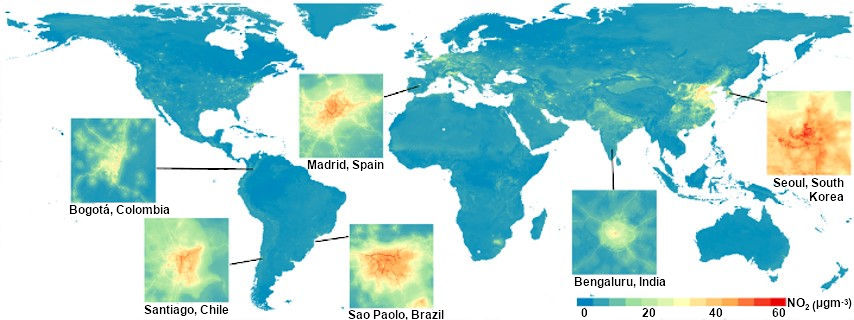Spatiotemporal prediction of air pollution
Poor ambient air quality represents one of the largest environmental risks to public health. Long-term exposure to air pollution is associated with chronic respiratory and cardiovascular diseases and contributes to an estimated 4.2 million deaths per year. Quantification of long-term exposures over a large population is required for epidemiological studies, risk assessment, and global burden of disease estimation. Personal Exposure Assessment (EA) that stresses individual activities and their local environment provides the most precise EA and has important implications in the understanding of the health impact of air pollution in both reality and urban planning scenarios. How the exposures are quantified and the potential for a reliable quality measure may greatly influence policymaking and our understanding of the health impacts.
High-resolution spatiotemporal air pollution modelling is required to capture spatiotemporal variability of the pollutant and emission sources and to incorporate human space-time activity patterns and other time-varying factors such as indoor-outdoor air exchange ratio for exposure assessment, as well as for calculating address-based health outcomes (home or hospital locations) and for understanding the health effects of specific population subgroups, e.g., exposure at different trimesters of pregnancy.
 |
A Statistical modelling approach predicts at unknown target spatial locations and times by capturing relationships between response and covariates (regression) and modelling the spatial or spatiotemporal processes of the observations and covariates (geostatistics) or learning features from images (computer vision and deep learning). Linear and ensemble tree-based regression methods (e.g. random forest and boosting) are the most widely used in high-resolution air pollution mapping. The response variable is commonly ground station measurements. From linear regression to deep learning, the model is likely less interpretable and continuous but better at capturing the complex process (with sufficient data), this stresses the role of model comparison and raises the question if an all-around model could be developed.
Spatiotemporal scales are important considerations in air pollution modelling . In general, challenges induced by data (ground measurements and geospatial predictors) deficiency and heterogeneity (spatial distributional and the generation mechanisms), and the modelling of the complex air pollution processes escalate with an increase in spatiotemporal scales (e.g. from city to global, annual average to hourly). For example, the estimation of population, which is an important covariate in Nitrogen Dioxide (NO2) modelling, possesses a high uncertainty in many African countries. The atmosphere is likely to behave less coherently over larger areas with respect to the dispersion and emission processes. The relationships between NO2 and geospatial predictors may vary spatiotemporally. For example, the same traffic loads in a certain area may relate to NO2 differently due to different types of fuel (e.g. ethanol vs. petrol) and power source (e.g. electric) of vehicles. Our goal is to understand statistical modelling of air pollution and improve the prediction accuracy at different spatial and temporal scales.
Related publication
- Meng Lu, Oliver Schmitz, Kees de Hoogh, Qin Kai, Derek Karssenberg,
Evaluation of different methods and data sources to optimise modelling of NO2 at a global scale,
Environment International, Volume 142, 2020, 105856, ISSN 0160-4120,
https://doi.org/10.1016/j.envint.2020.105856.
- Meng Lu, Ruoying Dai, Cjestmir de Boer, Oliver Schmitz, Ingeborg Kooter, Simona Cristescu, Derek Karssenberg,
External validation for statistical NO2 modelling: A study case using a high-end mobile sensing instrument,
Atmospheric Pollution Research, Volume 12, Issue 11,2021, 101205, ISSN 1309-1042,
https://doi.org/10.1016/j.apr.2021.101205.
- Meng Lu, Ivan Soenario, Marco Helbich, Oliver Schmitz, Gerard Hoek, Michiel van der Molen, Derek Karssenberg,
Land use regression models revealing spatiotemporal co-variation in NO2, NO, and O3 in the Netherlands,
Atmospheric Environment, Volume 223, 2020, 117238, ISSN 1352-2310,
https://doi.org/10.1016/j.atmosenv.2019.117238.
